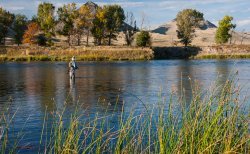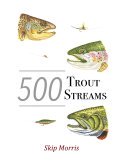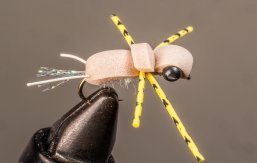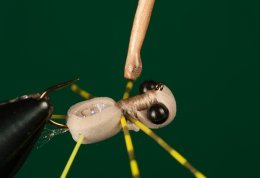The Truth About Chironomids
Part Three
by Carol Ann Morris
(originally published in Fly Fishing
and Tying Journal, Spring 2006)
In The Truth About Chironomids Part Three, Carol discusses the unique characteristics and behavior of Chironomids that make them such an important food source for trout, and an essential part of the fly fisherman's arsenal.
The article concludes with three hot chironomid pupa patterns designed by the experts.
Chironomids are "Fast Food" for Trout
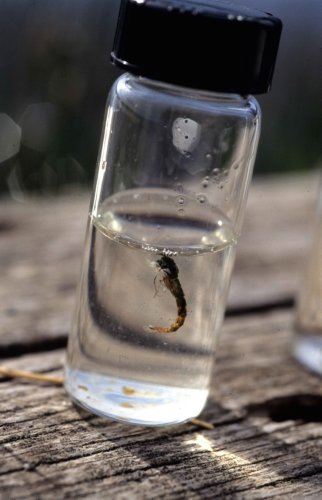 A Chironomid pupa displayed
A Chironomid pupa displayed
in a sample collection vial.
To understand why it is important to fish with Chironomid imitations, it is necessary to look at their characteristics in general.
Chironomids are fast food for trout in lakes. Abundant in number—more than 5,000 species exist world-wide—they are found anywhere and everywhere in lakes: rocky areas, plants, sand, silt, and most commonly, mud.
They come in a variety of colors, and in sizes from one to two millimeters up to 25 millimeters. They hatch all year 'round, and have their developing stages, larva and pupa, occur deep in lakes where they are easy prey and there is good cover for trout.
These combined characteristics make them a steady, easily available food source on which trout can depend.
It's A Chironomids' Life
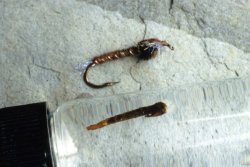 A Chironomid pupa imitation next to a
A Chironomid pupa imitation next to a
real Chironomid pupa matching color and size.
From these facts alone, it isn't hard to see why trout probably eat Chironomids more often than anything else that hatches in lakes.
But, in addition to knowing their characteristics, it is also important to understand the parts of the life cycle that make it vulnerable to trout.
Chironomids have a complete life cycle that progresses from egg to larva to pupa to adult.
Trout feed on all these stages except the egg.
The female Chironomid, during her egg-laying flight, dips her abdomen into the water, releasing the eggs just below the surface. The eggs then settle to the lake floor, and soon become larvae. Most fly fishers refer to this larval form as a "bloodworm" due to a hemoglobin-like substance in their body that makes them appear blood-red.
It is important to note, however, that this stage also occurs in shades of green and brown.
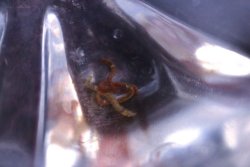 The larval form of the Chironomid,
The larval form of the Chironomid,
called the bloodworm.
Note that these larva vary in color.
After molting several times, the larva seals itself in a tube in the mud, and becomes a pupa.
The pupal stage is probably the one that is most commonly fed on by trout, because it is the stage that is most abundant throughout all the layers of a lake.
From the Mud to the Surface:
A Fresh Look at the Chironomids' Migration
It is often thought by anglers that Chironomid pupae migrate directly from their mud tubes to the surface to hatch. However, Brian Chan (a well-known fisheries biologist from British Columbia and Chironomid fishing expert) has documented another aspect of this insect's life style that explains why fishing these imitations deep works so well.
He took a team and an underwater camera to one of his area lakes to videotape migrating pupae.
What he found is that after leaving their mud tube, the pupae swirl around in the water one to two feet off the bottom of the lake bed. During this process, they mature (stage) for three to five days before they make their journey to the surface to hatch as adults.
This explains why the first one to two feet off the lake bottom is often so productive, and also why trout often take Chironomid pupa imitations deep in the lake when there is no evidence of a hatch on the surface.
The rest of their migration is common knowledge: they ascend to the top by means of air trapped in their shucks—the buoyancy is what takes
them to the surface.
They wiggle, squirm, and jerk their way to the top, and this is a very slow ascent.
So this slow journey, in addition to all their motion, makes them very vulnerable to trout. Trout don't have to expend much energy to eat them.
They are deep enough to offer safe cover for feeding trout from other predators, and they can hatch en masse, so there is no shortage of food.
An easy meal, good safe cover, and abundance: this is the ideal feeding situation for trout.
Do Trout Target
Chironomid Larvae and Adults?
Trout also feed on the larvae and adults, but probably not as often as they feed on the pupae. Larvae will leave their mud tubes to feed on vegetation, and this is when they are likely to be targeted by trout.
Brian has noticed some lakes in British Columbia where fish consistently take the adults at the surface, but only on a few of the lakes found in the Kamloops area.
Skip has fished the lakes on the west side of Washington state for over 40 years, and he has found that trout there do consistently feed on Chironomid pupae at the surface, and on adult Chironomids. He feels the main reason they feed on adults there is because the lakes are not very productive (ie, few insects, few hatches), so the trout need to take advantage of any food, in any form, that they can find, and because the pupae and new adults are concentrated on the surface.
Imitating the Wiggle of the Natural
One of the biggest challenges of fishing a Chironomid pupa imitation is to get it to move in the jerking, wiggling, squirming motion of the natural.
With the standard technique, fly fishers depend on the indicator bouncing on the surface waves to make the fly active. The quick-strip technique uses four to five rapid quick strips to emphasize and exaggerate this motion in the fly, and to draw the trout's attention to it.
An open-loop knot, such as the 98% Knot or the non-slip mono loop knot described by Lefty Kreh, allows the fly to swing free on the tippet. Make sure you use a knot that retains the loop after the strike.
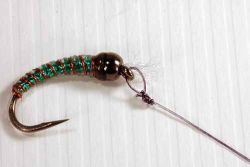 The non-slip mono loop knot allows the fly to
The non-slip mono loop knot allows the fly to
move freely in the water, creating more action.
This loop will not close down after
a strike.
The tippet was darkened with a marker
so it would show up easily in the photo.
The Duncan loop knot has been used a lot for this purpose, but the loop closes after the strike and has to be teased open again after the trout is released and before you cast again.
Another easy way to mimic the motion of the ascending pupa is to use a fly like Pete's Wiggler designed by Peter Morrison. This is a jointed Chironomid pupa imitation that has a separate abdomen attached to the hook, so it moves independently of the main fly. You get the wiggle, squirm, and jerk of the natural from the fly itself, without having to depend on the indicator or wave motion.
Fishing Deep Chironomid Pupa Techniques
with Mayflies, Damsels, Dragons, and Leeches
Neither the indicator technique nor the quick-strip technique are limited to Chironomid pupa imitations.
Peter, Kelly, Brian, and Skip have used these techniques successfully with other nymph patterns: mayflies, damsels, dragonflies, and even leeches.
Endorsed by the Experts:
Three Hot Chironomid Pupa Patterns
Pete's Wiggler
(designed by Peter Morrison)
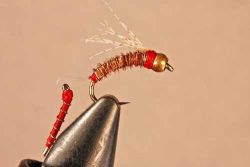 Pete's Wiggler designed and
Pete's Wiggler designed and
tied by Peter Morrison.
Hook: Any straight-shank hook, ring or down-eye (for the extended body).
Thread: Red 6-0 or 8-0.
Body: Red working thread, or red floss.
Rib: Fine gold or copper wire.
Abdomen Hinge: Monofilament fluorocarbon, six-pound-test (Peter suggests Berkley Vanish).
Hook: 2457 Tiemco, sizes 16 to 12 (for the thorax-half of the fly).
Bead: Gold or copper.
Thread: Red 6-0 or 8-0.
Rib: Fine gold or copper wire.
Body: Pheasant tail.
Wing: Mallard-flank tips.
Comments: Cut off the hook's bend after the abdomen is completed and the mono-loop hinge is securely bound on; this makes the process easiest to manage.
Shove the ends of the monofilament under the bead on the thorax hook, and then wrap the thread down to the bend.
Gummy Worm
(designed by Skip Morris)
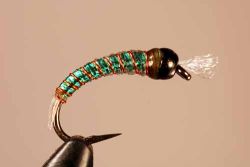 Gummy Worm designed and
Gummy Worm designed and
tied by Skip Morris.
Hook: Heavy wire, 1x long (curved or straight shank), size 16 to 10.
Thorax (bead):A black metal bead, 1/8 inch for hooks size 12 and larger, 3/32 inch for 14 and 16, or without a bead, Arizona Sparkle Nymph Dubbing
in "olive black".
Thread: 6/0 or 8/0 in a color similar to the abdomen's color.
Gills: White Antron yarn.
Rib: Fine copper wire.
Body: A 1/8-inch-wide strip of clear latex (Stretch-Flex, Scud Back, or the like) over black, brown, red, tan, green, or cream Krystal Flash or
Flashabou.
Comments: the latex strip is tremmed to a longish taper on one end, bound over the tip of that taper atop the hook's bend; then the Flashabou is bound on in front of the latex and wound forward, the latex is wrapped up the abdomen, and the copper wire wound as ribs. You can also use colored latex over clear Flashabou.
Amber Mini Flat Braid Pupa
(designed by Brian Chan)
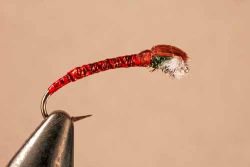 Mini Flat Braid Pupa designed and
Mini Flat Braid Pupa designed and
tied by Brian Chan.
Hook: Mustad C53s or TMC 2302, sizes, 12 and 10.
Thread: 8/0 chocolate brown.
Butt: Red holographic tinsel.
Abdomen: Amber Lagartun's French Mini-Flatbraid.
Rib: Fine red holographic tinsel.
Thorax: Peacock herl.
Gills: White Antron yarn lashed sideways.
Shellback: Ring-necked pheasant-tail fibers.
This concludes the three-part article on Chironomids covering the benefits of fishing pupa imitations deep, the life-cycle of this important lake insect, and a detailed explanation of the quick-strip technique that originated in British Columbia's wild lakes.
Click here to hear Skip's interviews on popular podcasts...
*Announcements*
Skip has an essay in Big Sky Journal's annual Fly Fishing issue, called "Montana Hoppers: the Princess and the Brute" released February 1, 2023. Skip rewrote it a bit; I painted and illustrated it here, on our website. Here's the link on our web page to check it out:
Click here to read Skip's essay Montana Hoppers: The Princess and the Brute...
Skip's latest books:
Top 12 Dry Flies for Trout Streams: How, When, and Where to Fish Them, is now available on Amazon as an ebook...check it out! Click on the links below to go to the information page on Top 12 Dry Flies (the link to Amazon is at the bottom of the page...)
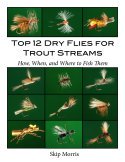 Top 12 Dry Flies for Trout Streams: How, When, and Where to Fish Them
Top 12 Dry Flies for Trout Streams: How, When, and Where to Fish Them
Click here to get more information about
Top 12 Dry Flies for Trout Streams: How, When, and Where to Fish Them (the link to Amazon is at the bottom of the page)...
Top 12 Dry Flies for Trout Streams: How, When, and Where to Fish Them (the link to Amazon is at the bottom of the page)...
Top 12 Nymphs for Trout Streams: How, When, and Where to Fish Them, 2nd Edition, originally published as an e-book only, is now available on Amazon as a paperback...check it out! Click on the links below to go to the information page on Top 12 Nymphs (the link to Amazon is at the bottom of the page...)
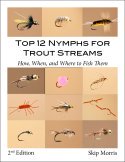 Top 12 Nymphs for Trout Streams: How, When, and Where to Fish Them (2nd Edition)
Top 12 Nymphs for Trout Streams: How, When, and Where to Fish Them (2nd Edition)
Click here to get more information about
Top 12 Nymphs for Trout Streams: How, When, and Where to Fish Them (2nd Edition). . .
Top 12 Nymphs for Trout Streams: How, When, and Where to Fish Them (2nd Edition). . .
Click here to get more information about Skip's e-book,
500 Trout Streams...
500 Trout Streams...
Skip's latest paperback book:
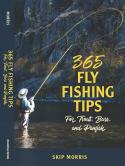 365 Fly Fishing Tips for Trout, Bass, and Panfish
365 Fly Fishing Tips for Trout, Bass, and Panfish
Click here to get more information about Skip's latest book,
365 Tips for Trout, Bass, and Panfish...
365 Tips for Trout, Bass, and Panfish...
Print Skip's chart for FREE:
Skip Morris's Trout-Fly Proportion Chart
Go to Skip Morris's Trout Fly Proportion Chart
Skip's Predator is available to buy...
Skip's ultra-popular Predator—a hit fly for bluegills and other panfishes and largemouth bass (also catches smallmouth bass and trout)—is being tied commercially by the Solitude Fly Company.
The Predator
CLICK HERE to learn more about or to purchase the Predator...
Learn to Tie Skip's Predator
Do you want to tie the Predator?
Tying the Predator
Skip shows you how to tie it on his YouTube Channel link, listed below:
CLICK HERE to see Skip's detailed video on how to tie the Predator...





